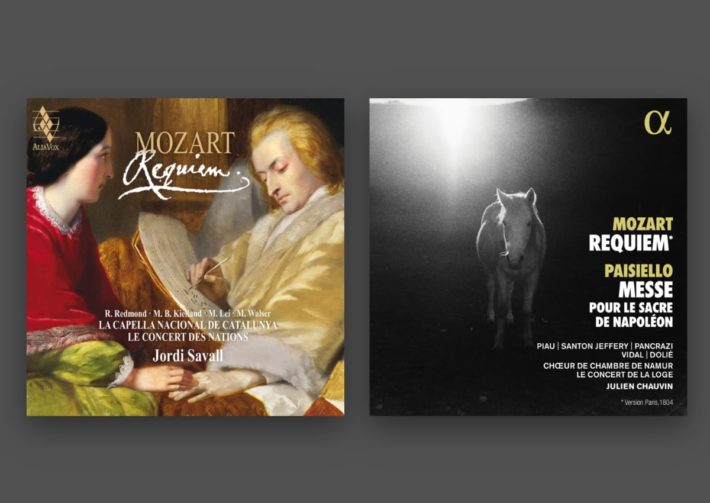Hardly a month passes by without another new recording of Mozart’s unfinished masterpiece. Since November 2022 we have had performances conducted by Felix Koch (Rondeau), Hervé Niquet (Château de Versailles), as well as re-releases led by Roger Norrington (Erato), Nigel Short (Warner Classics), and Claudio Abbado (DG). Three of these albums use editions different than the traditional Süssmayr.
Amazon: Mozart – Requiem – Jordi Savall, Le Concert des Nations


This is Savall’s second recording: the first, recorded in 1991, garnered mostly positive reviews. Having greatly admired Savall’s recent Beethoven and Schubert albums, I was eager to hear his interpretation of this masterwork. But the opening ‘Requiem aeternam’ immediately set off alarm bells. Never have I heard it played this fast, moving in 4 instead the subdivided 8 most conductors (including Savall in his first recording) adopt. The effect is brusque and perfunctory, imparting little sense of the grief experienced in the recordings by Gardiner (Philips), Suzuki (BIS), and Abbado.
The recording, made in a reverberant space, sometimes masks singers’ diction, and it is surprising Savall’s choir makes no attempt to sing Germanized Latin. The ‘Kyrie’ fugue, taken at quite a lick, lacks dynamic contrast and contrapuntal clarity is sometimes lost. The four soloists are unified in their approach and blend well as a quartet, but the male soloists often disengage from the mood of the text, notably in their first entries (Tuba mirum, track 4) and in the ‘Recordare.’ That movement also seems loud – rarely do the singers offer a true pianissimo.
This is also a problem with the choir: at the end of ‘Rex Tremendae’ the choirs sing ‘Salva me’ (Save me) too loudly, negating the sense of damned people begging for mercy. And in the ‘Confutatis’ the women are again too loud, which minimizes the contrast between the men (suffering in hell with the flames of hell licking at their feet) with the women who are already in heaven.
The orchestral writing is heard with greater clarity, which means Süssmayr’s unidiomatic writing is brought to the fore. His scoring for ‘Recordare’ is simply too heavy. Savall, like so many period instrument conductors before him, would probably argue using the Süssmayr edition because it is the only one done by someone who worked in Mozart’s time and who perhaps spoke to the composer about how to finish it. Yet we know Eybler, a much better composer, worked on it before Süssmayr, orchestrating everything up the Lacrimosa, and that his version is far more Mozartian. Why conductors refuse to use Eybler’s edition is beyond me.
The remainder of the performance has similar issues. The lack of atmosphere makes the entire reading rather matter of fact, especially when set beside the far more emotionally involved readings of Gardiner, Herreweghe (Harmonia Mundi), Harnoncourt, and indeed Savall’s first recording.
Related Classical Music Posts
- Review: Haydn – Die Schöpfung (The Creation) – Savall
- Review: Pergolesi – Stabat Mater – Jodie Devos, Adèle Charvet, Julien Chauvin
- Mozart – Requiem – A Beginners Guide
Chauvin’s performance is far more fascinating, a recreation of the work’s first Parisian performance in December 1804. The full Requiem is not performed: instead, the performance begins with a setting of ‘Requiem aeternam’ by Niccolò Jommelli (who was incredibly popular with French audiences at the time), which it then followed by Mozart’s setting (in a slower and more refined reading than Savall’s). Instead of the ‘Kyrie’ fugue, a simple d-minor chord is sounded, immediately followed by the ‘Dies irae’ (where one notes the French pronunciation of Latin). The Tuba mirum brings another surprise, with all the winds playing the opening fanfare to thrilling effect. The rest of the Sequenz receives a dramatically engaged reading, with clear choral diction and a wider dynamic range to the singing.
After the ‘Lacrimosa’ (which features lovely pianissimo singing), the ‘Domine Deus,’ ‘Hostias,’ ‘Sanctus,’ ‘Benedictus’ and first part ‘Agnus Dei’ are cut (perhaps the French believed most of this music was by Süssmayr and therefore not worthy of inclusion?) The performance ends with a spritely rendition of the ‘Cum sanctis’ fugue.
The remainder of the Alpha album features the ‘Messe pour le sacre de Napoléon,’ written for Napoleon’s 1804 installation on the imperial throne by his favorite composer, the Italian Giovanni Paisiello. The writing provides quite a contrast with the dark grief of the Requiem. It is unfailingly pleasant but never explores the depths of the mass texts. Its most interesting feature, a harp and horn duet, appears in the ‘Et incarnatus est’ (track 20). Apparently this combination was often heard in Empress Josephine’s salon. The mass’s first performance was at Notre-Dame, with more than 300 musicians divided into two orchestras and two choirs. The recording uses far smaller numbers, resulting in a more sweetly intimate reading.

Mozart – Requiem
La Capella Reial de Catalunya
Le Concert des Nations
Jordi Savall – Conductor
AliaVox, CD AVSA9953

Mozart – Requiem, Paisiello – Messe pour le sacre de Napoleon
Chœur de Chambre de Namur
Le Concert de la Loge
Julien Chauvin – Conductor
Alpha Classics, CD ALPHA919

Recommended Comparisons
Koch | Norrington | Abbado | Niquet
Read more classical music reviews or visit The Classic Review Amazon store
Follow Us and Comment:
Get our periodic classical music newsletter with our recent reviews, news and beginners guides.
We respect your privacy.









